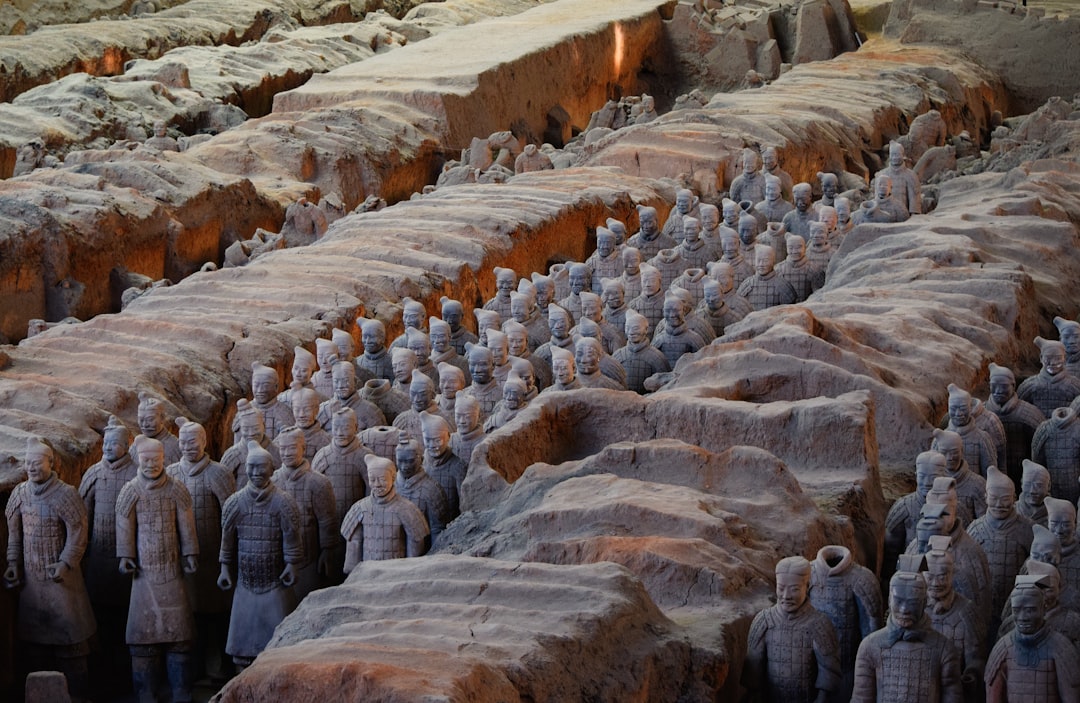Introduction
Colors possess the silent but profound ability to evoke emotions, convey messages, and even influence decisions. This intriguing intersection of art, psychology, and culture forms the crux of marketing strategies and has roots deeply entrenched in the practices of ancient civilizations. Understanding the multifaceted role of colors is not just an asset but a necessity in the dynamic fields of marketing and branding. As we embark on this colorful journey, we will delve into the critical importance of colors in marketing, decipher color psychology, and unearth the culturally significant use of colors by ancient civilizations. This exploration aims to shed light on the powerful impact colors have had throughout history and how this knowledge is leveraged in today’s marketing landscape to influence consumer behavior and perception.
Importance of Colors in Marketing
 Image courtesy: Unsplash
Image courtesy: Unsplash
Colors are not just mere decorations; they are an essential tool in marketing that can significantly influence consumer perceptions and actions. From brand logos to product packaging, colors help to convey messages and evoke specific emotions, making them a crucial element in creating a compelling marketing strategy. The psychology behind color selection and its impact on consumer behavior further highlights the power of colors in the marketing world.
Color Psychology in Marketing
Color psychology is the study of how colors affect perceptions and behaviors. In marketing, understanding color psychology is paramount as it helps in choosing colors that align with the brand’s message and values. For instance, blue is often associated with trust, security, and stability, making it a popular choice for banks and tech companies. On the other hand, red evokes feelings of excitement, passion, and urgency, which is why it is frequently used in clearance sales. Green, symbolizing health, tranquility, and nature, is often used by organic and eco-friendly brands. By leveraging these associations, marketers can create branding and packaging that resonate with their intended audience on a subconscious level.
Colors not only help in branding but also influence the way consumers interact with advertisements. Certain colors can attract more attention, enhance memory recall, and even encourage specific actions such as making a purchase. As such, marketers meticulously choose colors that not only match the brand’s personality but also optimize customer engagement and conversion rates.
Impact of Colors on Consumer Behavior
The influence of colors on consumer behavior is profound. Colors can affect consumers’ perception of a brand, influence their purchase decisions, and even sway their emotions toward a product or service. A well-chosen color scheme can enhance brand recognition by up to 80%, according to a study by the University of Loyola.
For example, fast-food chains commonly use red and yellow in their branding. Red triggers stimulation, appetite, and hunger, while yellow grabs attention and evokes feelings of happiness and friendliness. This combination not only increases appetite but also encourages quick decision-making, aligning perfectly with the fast-food industry’s goals.
Moreover, color preferences can vary based on demographics such as age, gender, and cultural background, affecting how products tailored to these groups are presented. Understanding these nuances enables marketers to tailor their strategies to target audiences more effectively, thereby increasing the relevance and appeal of their offerings.
Ancient Civilizations’ Use of Colors
 Image courtesy: Unsplash
Image courtesy: Unsplash
Ancient civilizations understood the significance of colors and used them not just for aesthetic purposes but also to represent cultural beliefs, societal hierarchies, and spiritual ideologies. From the rich blues of the Egyptians to the varied hues of the Chinese and Indians, colors played a pivotal role in daily life and cultural practices.
Colors in Ancient Egyptian Culture
In Ancient Egypt, color was a vital part of daily life, regarded not only for its aesthetic value but also for its symbolic meanings. The Egyptians used natural resources around them to create a vibrant palette that had significant cultural and religious importance. For instance, Blue, created from azurite and lapis lazuli, represented the sky and the Nile, symbolizing creation and rebirth. It was often used in the depiction of gods and the afterlife.
Green, symbolizing fertility, vegetation, and new life, was another important color made from malachite or crushed green minerals. This color adorned the walls of tombs and temples to evoke the idea of eternal life and regeneration.
Red, derived from ochre, represented chaos, fire, and desert. It was both revered and feared, used to represent both life and destruction. Pharaohs and deities were often depicted with red skin, underscoring their power and vitality.
Symbolism of Colors in Ancient Chinese Society
In ancient Chinese society, colors were laden with profound symbolism tied to philosophy, astrology, and the Five Elements theory. Each color held specific meanings and was used meticulously to reflect these beliefs.
Red, for instance, represented fire, happiness, and good fortune. It was the most auspicious color, used extensively in festivals and weddings, and on doors and windows to ward off evil spirits.
Yellow, the color of earth, symbolized royalty, power, and a connection to the heavenly realms. It was exclusively used by the emperor and his court, signifying their unique status and divine right to rule.
Black, associated with water, symbolized the void, heaven, and winter. It was considered a neutral color but held significant power in its association with the afterlife and the unknown.
Blue and green, representing wood, were symbols of growth, harmony, and renewal. These colors decorated ceramics, silks, and paintings, evoking the natural world’s beauty and the cycle of life.
Cultural Significance of Colors in Ancient Indian Civilization
In ancient Indian civilization, color held deep spiritual and cultural significance, with each hue representing various aspects of life, philosophy, and religion. The vibrant culture of India used colors not just in art and clothing but also in their festivals and rituals, embedding deep meanings into the fabric of daily life.
Saffron, a symbol of fire, purity, and sanctity, is considered the most auspicious color in India. It represents renunciation and the quest for light, used by Hindu monks in their attire, signifying their spiritual journey.
White, symbolizing peace, purity, and knowledge, is worn during times of mourning and by those seeking a life of simplicity and purity. It reflects the fundamental values of peace and tranquility in Indian philosophy.
Green, representing life, happiness, and fertility, is widely used during festivals and weddings. It symbolizes nature and the environment, echoing the importance of the natural world in Indian culture.
Red, signifies both sensuality and purity, is a dominant color in Indian weddings, symbolizing prosperity, fertility, and marital bliss. It is also associated with the goddess Durga, representing power and protection.
The ancient civilizations’ nuanced use of colors demonstrates their deep understanding of color’s power to communicate, symbolize, and influence. Modern marketing draws from these age-old principles, using color to connect with consumers on an emotional level, influence perceptions, and drive behavior. Just as in ancient times, colors continue to be a powerful tool for communication and expression in today’s global culture.
Comparing Modern Marketing Strategies with Ancient Color Practices
 Image courtesy: Unsplash
Image courtesy: Unsplash
The use of color in marketing is not a novel concept; its roots can be traced back to ancient civilizations, where color held significant cultural, social, and psychological importance. By examining how ancient cultures utilized color, we can gain insights into the sophisticated ways modern marketing leverages color psychology today. This comparison reveals not just continuity in the importance of color but also how its application has evolved over time to suit different societies’ needs and technological advancements.
Cultural Significance and Symbolism
Ancient civilizations were keen observers of color’s natural symbolism and cultural significance, incorporating it into everyday life, rituals, and art. For instance, in Ancient Egypt, green represented fertility and rebirth, reflecting the Nile’s lush vegetation. Egyptians would use green in tombs to symbolize hope and the promise of eternal life. Similarly, red in Ancient China symbolized good fortune and joy, dominating many cultural celebrations and imperial decorations.
In modern marketing, the symbolism of colors is leveraged to evoke specific consumer emotions and associations. Red, for example, is often used to create a sense of urgency or excitement, making it a popular choice for clearance sales. Green, aligning with its ancient connotations, is used to promote environmental and sustainable practices, tapping into consumers’ growing eco-consciousness.
Psychological Impact
The psychological impact of colors was well understood by ancient civilizations, although not in the empirical manner of modern psychology. Ancient Greeks, for example, believed in chromotherapy, where colors were used to heal; blue was thought to soothe illness and pain. Similarly, Egyptians adorned their pharaohs in blue as a symbol of divinity and godliness, believing it to have protective powers.
Today, the psychological effects of colors are a cornerstone of marketing strategies. Blue continues to symbolize trust, security, and calm, making it a preferred color for banks and health services. Yellow, associated with warmth and optimism, is used to grab attention and evoke a sense of happiness or comfort. Understanding these psychological impacts allows marketers to craft campaigns that resonate emotionally with their target audience, fostering engagement and loyalty.
Adaptation and Technology
One significant difference between ancient and modern use of color lies in the adaptation to technological advancements. Ancient civilizations were limited to natural pigments and dyes, which influenced the prominence and symbolism of certain colors in various cultures based on availability. The rarity of some colors, such as purple in Ancient Rome, which was derived from sea snails, made it exclusive to the elite, signifying wealth and power.
The industrial revolution and the development of synthetic dyes expanded the palette available for personal and commercial use, democratizing color and altering its symbolic meanings. In contemporary marketing, the ability to produce and display colors across various digital platforms has resulted in more sophisticated and nuanced use of color psychology. Marketers can now experiment with shades and hues to create brand identities, evoke desired emotional responses, and stand out in a saturated market.
Moreover, analytics and big data allow for a more targeted approach, enabling marketers to understand which colors perform best with certain demographics, further refining the application of color psychology in marketing strategies.
In conclusion, while the cultural and psychological significance of color has remained constant from ancient to modern times, the ways in which it is harnessed in marketing strategies have evolved dramatically. The adaptation to new technologies and the development of a more sophisticated understanding of color psychology have allowed for more effective and nuanced marketing approaches. By studying the roots of color significance in ancient civilizations, modern marketers can continue to innovate and connect with audiences on a deeper level.
Conclusion
In the vibrant tapestry of history, colors have always played a significant role, shaping societies, influencing decisions, and transcending mere aesthetics to become powerful tools of communication. Ancient civilizations were not only pioneers in the use of colors for artistic expression but also in understanding their deep psychological impacts and cultural significances. This wisdom, passed down through generations, has found its way into modern marketing strategies, where colors are employed to craft compelling narratives, evoke emotions, and influence consumer behavior.
The use of color in marketing is no mere happenstance; it’s a sophisticated technique grounded in the psychological nuances of color perception. Marketers and brands harness the power of colors to create brand identity, enhance customer engagement, and drive purchase decisions. The understanding that colors can affect mood, convey messages, and prompt action is pivotal in creating marketing materials that resonate with the target audience.
– Red, for example, is universally recognized for its ability to capture attention, stimulate appetite, and evoke feelings of excitement or urgency.
– Blue, on the other hand, is associated with trust, comfort, and serenity, making it a popular choice for technology and healthcare brands.
– Green resonates with nature, growth, and sustainability, often used by brands emphasizing eco-friendliness.
Drawing on the wisdom of ancient civilizations, modern marketers can tap into the cultural significances and emotional resonances attached to various colors to craft campaigns that are not only visually appealing but also culturally and emotionally engaging. The strategic use of color can bridge the gap between brand and consumer, creating a shared language that transcends words and taps into the universal human experience.
In conclusion, the judicious use of colors in marketing, inspired by ancient civilizations’ understanding and application, is more than an art; it’s a nuanced science. As we continue to navigate the ever-evolving landscape of consumer behavior and marketing strategies, the ancient roots of color psychology remind us of the enduring power of colors to communicate, persuade, and connect. Whether it’s the vivid hues of a marketer’s campaign or the subtle shades of an artist’s palette, colors continue to influence us in profound and enduring ways.